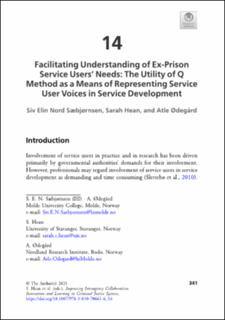| dc.contributor.author | Sæbjørnsen, Siv Elin Nord | |
| dc.contributor.author | Hean, Sarah Catherine Patricia Duff | |
| dc.contributor.author | Ødegård, Atle | |
| dc.date.accessioned | 2022-12-20T14:29:56Z | |
| dc.date.available | 2022-12-20T14:29:56Z | |
| dc.date.created | 2021-02-22T10:39:07Z | |
| dc.date.issued | 2021 | |
| dc.identifier.citation | Sæbjørnsen, Siv Elin Nord; Hean, Sarah Catherine Patricia Duff; Ødegård, Atle.
Facilitating understanding of ex-prison service users needs : the utility of Q method as a means of representing service user voices in service development. In: Improving interagency collaboration, innovation and learning in criminal justice systems. Supporting offender rehabilitation / Hean, Sarah Catherine Patricia Duff; Johnsen, Berit; Kloetzer, Laure; Kajamaa, Anu (eds.), pp. 341-374 | en_US |
| dc.identifier.isbn | 9783030706616 | |
| dc.identifier.uri | https://hdl.handle.net/11250/3038907 | |
| dc.description.abstract | Novel approaches are needed if the voices of prisoners as service users are to be heard in service development and organisational learning. In this chapter we introduce Q methodology and suggest how this research method can be applied in order to reveal the views of service users in contact with the criminal justice system. We illustrate this by describing the development of a set of Q statements used to elicit the perspectives of ex-prisoners’ experiences of service provisions in an UK mentorship organisation. We discuss how Q methodology can be applied to capture ex-prison service users’ views in research, in therapy or in dialogues between service user and mentor, as well as in including service users’ voices in service development. | en_US |
| dc.language.iso | eng | en_US |
| dc.relation.ispartof | Improving interagency collaboration innovation and learning in criminal justice systems : Supporting offender rehabilitation | |
| dc.relation.uri | https://doi.org/10.1007/978-3-030-70661-6_14 | |
| dc.rights | Navngivelse 4.0 Internasjonal | * |
| dc.rights.uri | http://creativecommons.org/licenses/by/4.0/deed.no | * |
| dc.title | Facilitating understanding of ex-prison service users needs : the utility of Q method as a means of representing service user voices in service development | en_US |
| dc.type | Chapter | en_US |
| dc.type | Peer reviewed | |
| dc.description.version | publishedVersion | en_US |
| dc.source.pagenumber | 341-374 | en_US |
| dc.identifier.doi | 10.1007/978-3-030-70661-6_14 | |
| dc.identifier.cristin | 1892228 | |
| cristin.ispublished | true | |
| cristin.fulltext | original | |
| cristin.qualitycode | 2 | |

